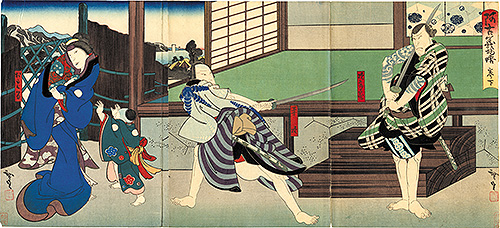Portraits of actors in Osaka: invitation to medium-sized woodblock prints
February 28 (Tue), 2023 ‐ May 28 (Sun), 2023
This museum exhibits ukiyo-e woodblock prints published in Osaka in the Edo period. Many of the ukiyo-e prints made in Osaka were portraits of kabuki actors performing on stage around Dotombori area, showing how the kabuki actors performed and what the stages were like.
Peak period of production of portraits of actors in Osaka is the19th century, the latter half of the Edo period. Large-sized woodblock prints (10.5 x 15.5 inches) were popular during the Bunka-bunsei era (1804-1830) and Tempo era (1830-1844) but they were prohibited by Tempo reforms (1841-1843). Then during Koka era (1844-1848), medium-sized woodblock prints (roughly 7.5 x 10 inches) became mainstream.
In this feature exhibition, we focus on medium-sized ukiyo-e portraits which was the most standard size for portraits in Osaka. Medium-sized prints were about half a size of large-sized prints and have different good points. Osaka ukiyo-e artists such as Hirosada and Yoshitaki made the most of the merits of the size. Please enjoy the world of medium-sized ukyo-e prints which characterize Osaka ukiyo-e.

“Seishu agogigaura”
made in October in Kaei 4 (1851),
performed at Chikugo shibai theater.
‘Large-sized woodblock prints and medium-sized woodblock prints’
Many woodblocks for ukiyo-e are large-sized, such as a famous “Fugaku 36 kei”. It is about 10.5 x 15.5 inches, slightly bigger than present B4 size. Woodblocks are used vertically for portraits, and when a couple of woodblocks are used for one portrait, it becomes more real as if the stage is in front of you. In large-sized woodblock prints large and small props are also depicted at the back, describing dynamically the stage with the actor at the center.
Medium-sized woodblock is about half a size of large-sized woodblock, roughly 7.5 x 10 inches, slightly smaller than present A4 size. Medium-sized woodblock prints became mainstream after Tempo reforms. As the size becomes smaller, depth is added with distant view at the back in order to take advantage of the smallness of the size.
These two ukiyo-e depict the same performance in large-sized and small-sized woodblocks respectively. See the difference between the medium-sized woodblock print which is characteristic of Osaka and large-sized woodblock print.
Tempo reforms is an attempt to restore severe feudal system initiated by Mizuno Tadakuni, chief adviser to the shogun. It was begun from around Tempo 12 (1841). It encouraged frugality, public order and morals, strictly controlled the pleasures such as kabuki plays enjoyed by the common people. Production and sales of kabuki actors’ portraits were prohibited.
But after Mizuno Tadakuni retired from the position, around Koka 4 (1848), production of actors’ portraits gradually revived. But in order to deveive the government, the word ‘loyalty and filial piety’ was used instead of ‘portrait’, depicting half-length figure, not the full body of an actor. Hirosada is a popular ‘loyaly and filial piety’ artist. He initially drew half-length figure of actors but in Kaei era (1848-1854) he began drawing actors performing on stage. Though the woodblock is medium-sized, smaller woodblock, but he depicted actors lively and dynamically.
Hirosada also drew large-sized ukiyo-e (displayed separately), published by Temmaya Kihei, who operated since before the Tempo reforms. Medium-sized woodblock is thought to be created in relation to copyrights.
Yoshitaki’s achievements and the end of portraits
After Hirosada, Yoshitaki dominated the world of Kamigata actors’ portraits. After becoming a disciple of Utagawa Yoshiume, ukiyo-e artist, Yoshitaki’s ukiyo-e became known in Ansei era (1855-1860). Initially his technique was poor in drawing actor’s arms and legs, but soon he started drawing actors with generous clothing and supple body, showing his individuality.
Yoshitaki’s work include a drawing that boldly puts a distant view at the back, a drawing that puts colourful stripes and genjiko patterns with no background, and a drawing that uses 3 vertical woodblocks in a low. Each of his drawing shows the prolific artist’s originality and individuality to produce medium-sized ukiyo-e prints.
However, ukiyo-e production gradually fell into a decline in Meiji era and Yoshitaki moved to Kyoto. Kawasaki Kyosen who became Yoshitaki’s disciple in Meiji 23 (1890), wrote that Yoshitaki ‘moved from Osaka to Kyoto in Meiji 13 (1880) after refusing all offers concerning ukiyo-e drawing. Yoshitaki might have given up on ukiyo-e because of its gradual decrease in demand.
Medium-sized woodblock prints other than portraits
Many of Osaka ukiyo-e woodblock prints are portraits of kabuki actors, but there are also bijinga (picture of a beautiful woman) and landscape pictures. Other than “Miyako Hyakkei” (one hundred views of the capital city) which is displayed here, there are “Naniwa Hyakkei” (one hundred views of Naniwa, present Osaka) and other series of landscape pictures, that were influenced by Utagawa Hiroshige. While “Meisho Edo Hyakkei” (one hundred famous views of Edo” is made with large-sized woodblocks, “Naniwa Hyakkei” is made with medium-sized woodblocks. You can say that medium-sized woodblock prints had taken root in Osaka ukiyo-e world.